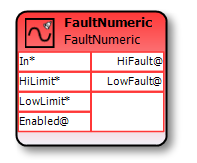
Detects a numeric fault. The fault conditions are detected when the input exceeds the limits of the HiLimit or LowLimit.
HiFault is True when the input is greater than the value entered in the HiLimit slot. LowFault is True when the input is lower than the value entered in the LowLimit slot.
Inputs |
|
|||||
|
Slots |
Type |
Default |
Description |
||
|
In |
Numeric |
Null |
The input to monitor, the default value is Null. |
||
|
HiLimit |
Numeric |
100.0 |
The high limit to compare against the input. If the input is greater than the HiLimit plus the deadband for a period of time greater than the delay, then HiFault will be True. |
||
|
LowLimit |
Numeric |
0.0 |
The low limit to compare against the input. If the input is less than the LowLimit minus the deadband for a period of time greater than the delay, then LowFault will be True |
||
|
Enabled |
Digital |
True |
Determines if the block is enabled. |
||
Outputs |
|||
|
Slots |
Type |
Description |
|
HiFault |
Digital |
True when the input is greater than the HiLimit plus the deadband for a time greater than the delay. |
|
LowFault |
Digital |
True when the input is less than the LowLimit minus the deadband for a time greater than the delay. |
Properties |
|||||
Slots |
Description |
||||
Delay |
The period of time the fault condition must persist before the output becomes True. |
||||
Deadband |
Defines a range of input values in which the output will not change state. For the HiLimit, the deadband range is from the HiLimit to (HiLimit + deadband). For the LowLimit the deadband range is from the LowLimit to (LowLimit – deadband). |
||||
|
Delay |
The input must be in Fault condition for this period of time (in seconds) before the output becomes True. |
|||